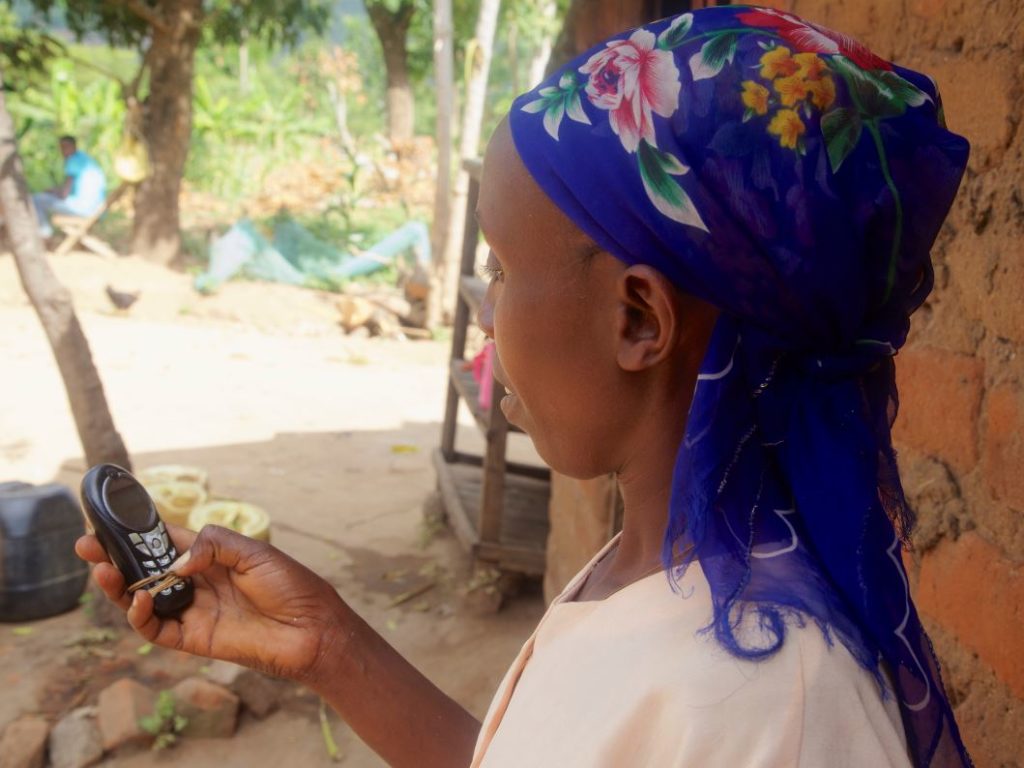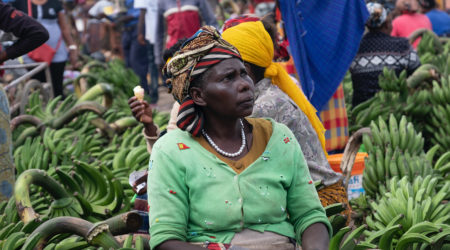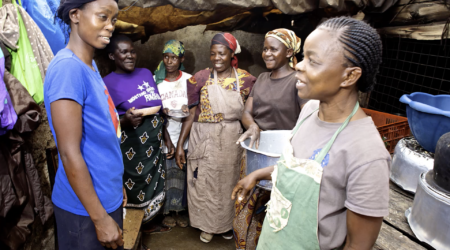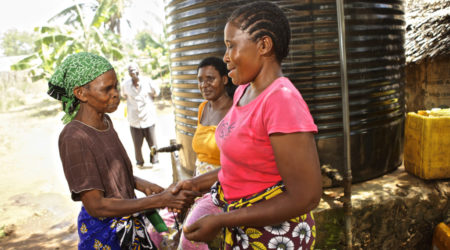Shamba bora (fertile farmland), Shamba la mawe (rocky farmland)

Originally posted on the FSD Kenya Website, April 14, 2020
Urban and rural areas are coping with the coronavirus disruptions in different ways
About how long will the food you have for now last, we asked Susan, 52, last week. The question alone made Susan tear up. She is extremely stressed trying to figure out how she will manage to get through this difficult period. She lives on a small farm in rural Makueni, where she grows some maize for consumption and receives some cash income from working on other people’s farms or washing clothes for them. That casual work has disappeared as former clients are doing the work themselves, not wanting to have outsiders coming to their homes. She still has about two months’ worth of maize, but has no idea how she will get the other things the family needs. Just before we called her, she had bartered some maize for a bit of bread and sugar.
Things have been hard in general since her husband died in 2013, but Susan carries a heavier burden now. One of her daughters got pregnant just after high school, and she now cares for both her daughter and her two-year old grandson. Susan’s sister, who is blind, also lives with her, and she is unable to work. Her son also lives on the compound, but rarely helps out. “He seems to never keep a job for very long, and even when he’s working, he doesn’t help much.” She had high hopes for her daughter, a teacher, but once she got married, she stopped sending money. “I literally live by the grace of God.” She has no real back up plan. She doesn’t expect the neighbours will be able to help much. Maybe there will be relief food, she says, she was planning to talk to the chief to see if there were any plans.
A hundred and fifty kilometres away in Mathare, Aunty has also lost her casual work washing clothes in Eastleigh. Aunty’s twin daughters both had babies during secondary school. Both now moved out. At home it’s just her with one granddaughter and a nephew. They live in a small one room house, so she feels like she can’t trap the kids inside, even though she worries that the kids might contract the virus from their playmates and bring it home.
Aunty is HIV positive, and hasn’t been feeling well for several months. She had only been going to do washing once or twice per week, and once she heard about coronavirus in Kenya she stopped completely. “If I get the virus, I’m sure I won’t survive.” She has heard that the antiretroviral drugs (ARVs) that keep her alive come from India and China. She is very worried that changes in international supply chains will mean the drugs run out in Kenya.
As the virus restrictions set in, she called her daughter to ask for help, and she brought over some food from her own kitchen. Her daughters have been trying to help her from some time. Between the two of them, they’ve been trying to send her about Ksh 100 (about $1) per day. But, both of their husbands work in the informal sector, and Aunty is worried what will happen as her sons-in-laws’ incomes decline.
She doesn’t have the option of taking a loan right now. About six months ago, she defaulted on a loan of Ksh 1,800 ($18) from M-Shwari. Two months ago, she failed to pay her Zenka loan. She’s sure she can’t borrow elsewhere since she hasn’t paid these debts.
With the help of her daughters, she has paid rent for April. She thinks the best option for now is to stay put in Nairobi. If the government helps anyone, they’re more likely to help people in Nairobi, she believes. If she runs out of food, she says she’ll go stay with her daughter and son in law who also live in the area.
As the Kenyan economy slows, many low-income people are seeing their incomes plummet and development practitioners are debating about where to target their interventions. Where are people most vulnerable? To what kinds of impacts?
But, after two weeks of calls to Kenya Financial Diaries respondents around the country, it’s very hard to say where the impact of coronavirus will sting most. We are not seeing a clear indication that the strain is more extreme in rural or urban areas. Households in both areas are reporting similar magnitudes of economic impact and report, at the median, similar levels of food in their homes. In both areas, there are families already hit tremendously by the disruption and others who say that nothing much has changed. However, we are starting to see that the nature of the strain is quite different in cities and rural communities.
In some ways, the strains of urban areas are more obvious. Cash-based incomes have been cut, often by half or more, even if some cash flow is still coming into the house. Under this kind of strain, food becomes the priority expense, and many are worried about paying rent and the risk of eviction. While many told us that they would go to their rural homes if they were evicted, movement restrictions have now made this impossible, blocking their backup plans. Urban families must leave the home to earn an income and keep their families afloat. When they do so, they enter into marketplaces that are crowded. But even staying at home requires being in close contact with others in cramped homes with shared toilets and water facilities. Fears of contracting the virus appear to be heightened in urban areas, especially Nairobi, also discouraging people from using ordinary services, including for example, keeping up with routine vaccinations and health checkups for chronic illness.
Many in cities also feel they can’t really call on neighbors to help. When our researcher asked whether there was more sharing of food and other resources in the neighborhood, Fiona scoffed. “Sharing?! No. Nairobi ni shamba la mawe.” [Nairobi is a tough place, literally “rocky farmland”.]
But many rural families are also under strain, perhaps less visibly so. Some rural families still have maize remaining from last year, given the healthy rains the country received. But not all families have enough to live on, especially now that their children are home from boarding schools and some husbands and other relatives have come from cities to stay in the rural areas throughout this period. The (typically female) hosts are worried that they will have to bear the strain of new dependents alone, forced to figure out some way to make their resources stretch. And not every rural family has a farm. A number of our rural respondents rely heavily on trading in markets or selling changaa, and they are seeing those incomes shrink dramatically even as the prices for maize meal and vegetables rise.
Just this week, we’ve seen rural supply chains breakdown as well. Those who grow vegetables in bulk have lost their markets as well and think they may be forced to just give away some produce, since their struggling neighbours can’t afford to buy from them. Those selling milk to wholesalers say they’ve been forced to stop selling. Collection facilities are not taking so much right now. And some respondents live in high-production areas, so they can’t really sell to neighbours either. Tea farmers this week are reporting that the Kenya Tea Development Agency (KTDA) has reduced how much tea it is accepting. Since tea must be sold quickly after plucking, farmers are diverting a share of their harvest to other, smaller factories, which don’t pay a year-end bonus. This came as quite the shock, and farmers are starting to worry about what that will mean for their households later in the year. Similarly, orange and mango producers in Makueni are having trouble getting the inputs they need to care for their trees. Those who provide pruning and spraying services say their clients have put this on hold. This raises questions about the quality of this year’s harvest, but farmers are also worried about investing a lot right now when they are uncertain whether the market will be available for them to sell when the fruits are ready. Some livestock markets have closed as well, leaving people wondering when they will be able to liquidate some of those assets.
In some sense, there is some food to share in some rural areas, even if people are more conservative about sharing anything they have had to purchase with cash. One person in a rural part of the Coastal region said that at least in the rural areas there are some wild vegetables that are free to everyone, and it’s a local norm to be able to use local coconuts and fruits in small quantities. But in all rural areas, cash is in short supply as remittances from urban relatives disappear. In some cases, those urban relatives are now asking rural kin to send them M-Pesa.
Both cash crop and food crop farmers are going into the crisis cash and food strapped from paying large sums for school fees early in the year. Many crop farmers sold their maize for school fees and cash crop farmers often took loans against future production for school fees. Now the kids are home, but resources are extra tight.
Summary of differences in the advantages and disadvantages facing rural and urban families.

It’s safe to say that the economic impact of coronavirus will spare no part of the country. Targeting the most vulnerable will require sensitive tracking tools and an open mind about the visible and hidden impacts playing out. It’s also true that beyond the obvious need for cash transfers in both areas, the range of interventions that might be most appropriate in urban areas is likely to be quite different from rural ones. And, though it may not be obvious, rural areas are in need of equally urgent intervention, for example, to rescue inclusive supply chains.



